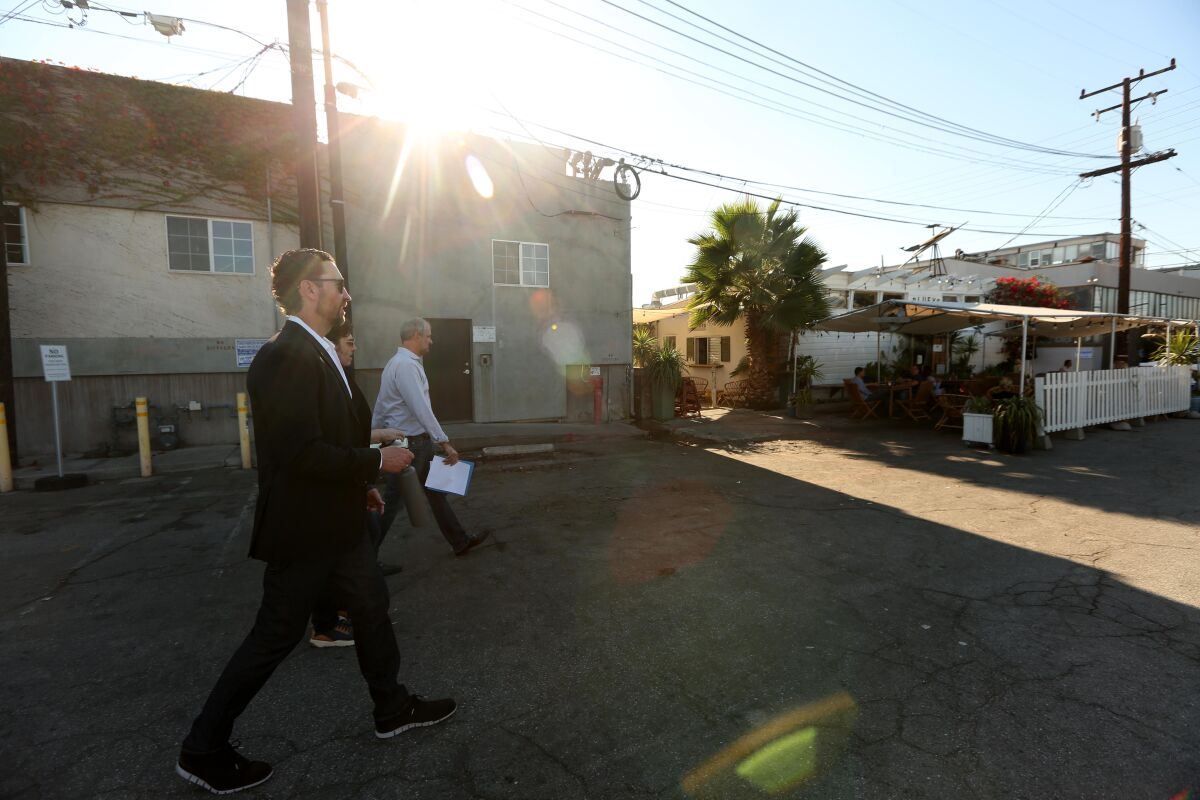Earlier this fall, a developer submitted plans for 4,500 apartments in Santa Monica — more new housing than the pricey, beachfront city has built in all of the previous decade.
And because of a little-used provision in state law that kicks in when cities fail to produce a housing plan to accommodate projected population growth, Santa Monica officials may be powerless to stop the construction.
The tactic now could be deployed by developers in more than 100 Southern California cities that are out of compliance with the state requirements. According to experts, it is most likely to be used in wealthier areas with little housing production and high potential profits.
The push for growth comes as Gov. Gavin Newsom and state legislators in recent years have passed laws eroding local controls over home-building, arguing that local resistance is a key reason behind California’s unprecedented housing shortage and high cost of living.
In response, developers are becoming increasingly willing to challenge city officials.
In Redondo Beach, a power plant owner has submitted plans for more than 2,200 housing units using the new tactic.

Walter, left, wants to build 4,500 apartments across 14 buildings, including a 15-story high-rise with 2,000 units that would be Santa Monica’s tallest outside its downtown.
(Genaro Molina / Los Angeles Times)
Dave Rand, an attorney advising Scott Walter, the developer of the Santa Monica projects, said he has fielded inquiries about the tactic in places like Beverly Hills, West Hollywood and Coronado.
“I’ve never had so many calls about any single subject in a shorter period of time,” Rand said. “It demonstrates how broken the system is in California, that people are so desperate to find an alternate pathway.”
Walter’s 4,500 apartments would be spread across 14 buildings, including a 15-story high-rise with 2,000 units that would be the tallest in Santa Monica outside the city’s downtown.
The plans have stunned local elected officials, with some worrying that the community will lose its distinctiveness.
Santa Monica Councilmember Phil Brock called the 15-story high-rise “beyond the pale” and an “unacceptable bar for the rest of the city.”
“Some of this growth will be destructive to the idea that Santa Monica somewhere along the line was supposed to be a beachside town,” Brock said. “As we blend into L.A., we’ll lose that character.”
He expects that he and his colleagues will try to block at least some of the projects.

Despite the tremendous demand to live in Santa Monica, the population is only slightly larger than it was in 1970 — it’s become expensive, and housing construction has slowed.
(Carolyn Cole / Los Angeles Times)
At issue is a 30-year-old section of state law colloquially known as “the builder’s remedy.”
If the requirement to produce a housing plan every eight years is violated, developers can essentially propose building whatever they want, provided some of the housing is set aside for low- or middle-income families.
The builder’s remedy has long sat unused, said Chris Elmendorf, a law professor at UC Davis who has researched the provision.
In recent years, however, state legislators have beefed up laws to make the builder’s remedy more viable by increasing penalties for cities that reject development and blocking attempts to reduce density. State officials, including Newsom and Atty. Gen. Rob Bonta, also have more assertively enforced housing rules, creating a friendlier environment for those hoping to use them.
State Sen. Nancy Skinner (D-Berkeley), who wrote some of the laws related to the builder’s remedy, said there should be consequences when cities don’t plan for sufficient growth.
“We haven’t taken away local control,” Skinner said. “The localities themselves gave up their local control when they chose to ignore state law.”
The state’s more aggressive stance has led to a cultural shift among frustrated developers. They are starting to rely less on fostering the goodwill of local officials and more on what the law allows them to build, Elmendorf said.
“Some developers are like, ‘Well, I no longer need to be friends with the city council. I just need to know my rights,’” he said. “So they can do things that otherwise would have been a death wish for their business.”
Beverly Hills, Huntington Beach, Malibu, Palm Springs, Pasadena and West Hollywood are among the 124 jurisdictions in Los Angeles, Orange, Riverside, San Bernardino and Imperial counties where the builder’s remedy could be in play because their latest housing plan hasn’t been approved, the state Department of Housing and Community Development confirmed.
Coronado, Del Mar and Solana Beach are among 11 cities in San Diego County in the same circumstances. Bay Area cities’ housing plans are due in January.
At its Oct. 11 meeting, the Santa Monica City Council approved a revised housing plan, which was then certified by state housing officials, putting the city in compliance.
But state officials have said that proposals such as the 14 that Walter submitted before then will still fall under the builder’s remedy. Two other developers also filed projects in Santa Monica before the deadline.
The 16 developments — Walter’s plus the other two — would create 4,562 new apartments, with 941 set aside for low-income residents.
Walter’s firm, WS Communities, is one of the biggest developers in Santa Monica, with 20 apartment buildings completed or under construction.
His proposed 15-story high-rise would be built on 3.3 acres that now house a parking lot and low-rise commercial businesses along Olympic Boulevard.
Walter had already obtained city approval to build a 183-unit apartment complex on the site. But because of rising interest rates and construction costs, he had to significantly expand the size of the project.
“We’ve have witnessed for a decade as the city has previously gone through zoning updates, how long and arduous the process that can be,” Walter said. “We just didn’t want to wait.”
For the last 50 years, housing politics have frequently set the agenda in Santa Monica, a city of 92,000 with an iconic pier and Ferris wheel.
During the 1970s, the city passed what was then one of the nation’s strongest rent control laws. It was also one of the first cities to force developers to provide affordable housing as an additional condition to get their projects approved.
In the decades since, regular disputes have erupted over proposals for large housing and commercial developments. Most recently, debates have centered on tearing down a downtown parking garage and replacing it with low-income housing, as well as building a 521-unit apartment building on what’s now a strip mall anchored by a grocery store. The latter project was the largest in the city’s development pipeline until Walter’s plans came along.
Despite the tremendous demand to live in Santa Monica, the population is only slightly larger than it was in 1970 — in large part because it’s become so expensive and housing construction has slowed.
Santa Monica’s median home value is nearly $1.9 million, almost $1 million higher than the average in the L.A. area, according to Zillow.
A newly leased two-bedroom apartment in the city rents for a median of $2,605 a month, 13% above the regional figure, per data from Apartment List.
The builder’s remedy projects are set to become the city’s next flashpoint.
A slow-growth group, Santa Monica Coalition for a Livable City, is urging the City Council to consider litigation to stop the projects.
“To say residents and council members are deeply concerned about this developer ambush and have questions that must be answered is an understatement,” the group said in a statement last week.
Leonora Camner, a Santa Monica resident and executive director of pro-growth organization Abundant Housing LA, said she would have preferred that the city had initially submitted a housing plan that passed state muster.
Failing that, a remedy that allows for housing to be built is preferable to the city retaining control over its land-use policies, she said.
“I don’t want to see a situation where builders can circumvent local planning,” Camner said. “But if cities can’t for political reasons, or whatever, pass housing plans, people suffer. I’m glad there are these consequences.”
One sticking point for the builder’s remedy projects could be the California Environmental Quality Act, which, especially for larger-scale efforts, could require a lengthy review of environmental effects and open the door to litigation.
Additionally, because the builder’s remedy is untested in court, legal questions remain over what developments qualify, said Elmendorf, the UC Davis law professor.
Because developers must dedicate at least 20% of units for low-income families or 100% for middle-income ones, the projects could be infeasible in less expensive areas with lower profit margins, he said.
Because of these uncertainties, Elmendorf doesn’t expect the builder’s remedy to lead to a massive surge in housing construction across the state.
“The only places where this is a real threat is where development is super expensive,” Elmendorf said.
